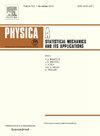Dynamics of network structure in cryptocurrency markets during abrupt changes in Bitcoin price
IF 2.8
3区 物理与天体物理
Q2 PHYSICS, MULTIDISCIPLINARY
Physica A: Statistical Mechanics and its Applications
Pub Date : 2025-01-30
DOI:10.1016/j.physa.2025.130404
引用次数: 0
Abstract
Network modeling is a powerful approach to study agent interactions that can provide insights into dynamics and behaviors of complex systems. Cryptocurrency market stability can be assessed by analyzing changes in network structures, where cryptocurrencies serve as nodes in the network, and the network’s weights of connectivity represent the strength of their relationships. This study examines the roles of weighting methods — correlation, mutual information, and Fisher information distance (FID) — in constructing cryptocurrency networks, and how they perform when abrupt changes occur in the Bitcoin price. Each weighting method offers unique insights into cryptocurrency relationships. Results show that sudden Bitcoin price shifts impact the cryptocurrency network’s structures, including characteristic path length, hubs, and minimum spanning trees, providing insights into market stability and clustering behaviors. Additionally, the Granger causality test reveals that the Bitcoin’s returns drive the cryptocurrency network’s connectivity and structure changes. However, the converse is not true, suggesting that the collective behaviors of cryptocurrencies are strongly influenced by the BTC price movement, but not vice versa. The study highlights weighting methods as valuable tools for network analysis and portfolio management using minimum spanning trees.
求助全文
约1分钟内获得全文
求助全文
来源期刊
CiteScore
7.20
自引率
9.10%
发文量
852
审稿时长
6.6 months
期刊介绍:
Physica A: Statistical Mechanics and its Applications
Recognized by the European Physical Society
Physica A publishes research in the field of statistical mechanics and its applications.
Statistical mechanics sets out to explain the behaviour of macroscopic systems by studying the statistical properties of their microscopic constituents.
Applications of the techniques of statistical mechanics are widespread, and include: applications to physical systems such as solids, liquids and gases; applications to chemical and biological systems (colloids, interfaces, complex fluids, polymers and biopolymers, cell physics); and other interdisciplinary applications to for instance biological, economical and sociological systems.

 求助内容:
求助内容: 应助结果提醒方式:
应助结果提醒方式:


